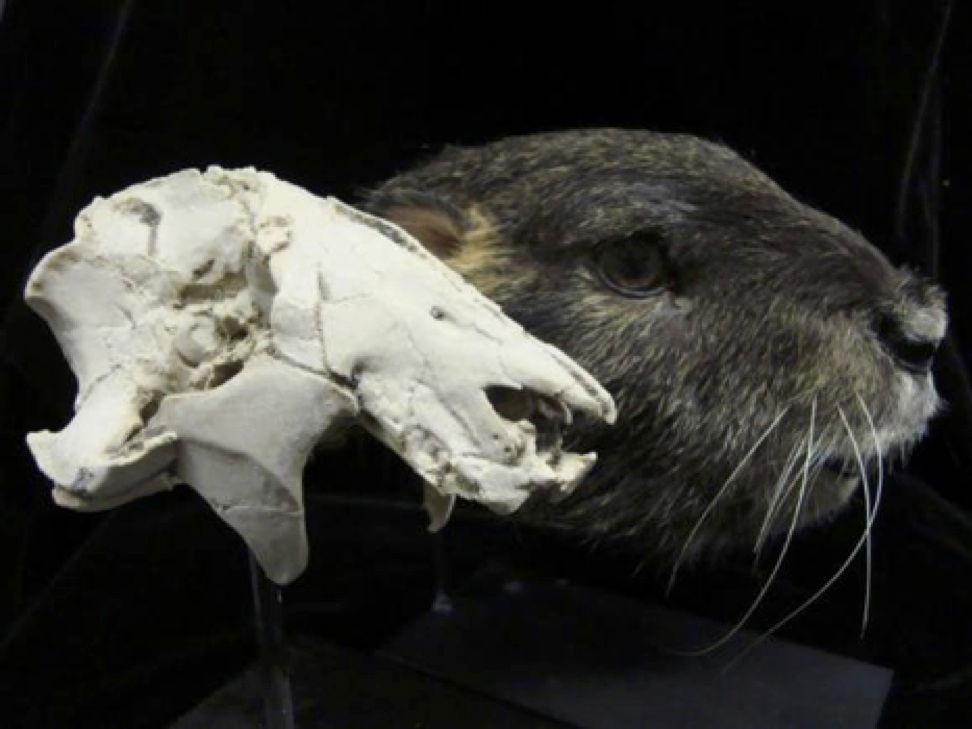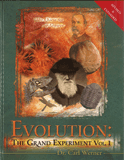
Rodent-like Mammal Shakes the Evolutionary Tree
News to Know
Abstract
Does this giant groundhog-like animal that shared the world with dinosaurs tell us anything about how we evolved?
News Source
The lucky discovery of a 5-inch long skull belonging to an extinct 20-pound Mesozoic groundhog-like animal threatens to rewrite the evolutionary history of mammals. Dubbed Vintana sertichi (because “vintana” is Malagasy for “lucky”), the skull (minus its lower jaw) was found fossilized in Madagascar with lots of fish in a large block of sandstone dated late in the “age of dinosaurs.” Believed by evolutionists to have inhabited a large southern land mass known as Gondwana 66 million years ago, it is the first good representative of the gondwanatherians, previously known only from isolated teeth and jaw fragments.

In the foreground here is a cast of a fossilized skull found in Madagascar. About 5 inches long, scientists have named it Vintana sertichi. It belonged to a group of extinct mammals that differed in several respects from the three main categories of mammals, and it is the first intact specimen of that group, the gondwanatherians, to be found. The large triangular bone pointed downward is not a tooth but rather a jugal bone. The jugal bones are part of this animal’s massive cheekbones that would have provided support for strong masseter (chewing) muscles and given it a powerful bite. Behind the cast is an artist’s reconstruction produced by Staab Studios. Image: Reuters/Joseph Groenke/Stony Brook University/Handout via Reuters
Uncovering Our Mammalian Roots?
Vintana is “the discovery of the decade for understanding the deep history of mammals,” according to mammal evolution expert Zhe-Xi Luo of the University of Chicago. Zhe-Xi Luo was not involved in this study but not long ago discovered the highly advanced design of another extinct group of mammals once thought to be primitive. Commenting on Vintana, he says,
This mammal helps to stretch our imagination of what is possible by evolution beyond our stereotypes from the extant mammals. Early mammal history is our own history—that is why a discovery of this kind is important, because it may prompt us to re-think our own evolutionary past.
Mammalian Mosaic
What is so unusual about Vintana’s skull? It isn’t so much the individual features but rather the fact that mammalian traits which evolutionists consider primitive and those they consider advanced are found together that has evolutionary scientists excited. “Its craniofacial anatomy reveals that it was herbivorous, large-eyed and agile, with well-developed high-frequency hearing and a keen sense of smell,”1 Krause and colleagues write in Nature, adding, “The cranium exhibits a mosaic of primitive and derived features, the disparity of which is extreme and probably reflective of a long evolutionary history in geographic isolation.”1 The skull is similar to the skulls of multituberculates, a diverse group of extinct rodent-like mammals with bumpy back teeth. (Multituberculates, officially considered “primitive” despite the advanced design features discovered by Dr. Luo, are found in the same rock layers as dinosaurs as well as in rock strata above them, but so far only in the northern hemisphere.)
The term mosaic refers to animals that share traits ordinarily associated with several different categories of animals. A common example would be the platypus—an egg-laying mammal with a bill like a duck. The evolutionary authors are using the term mosaic because they believe the bony details of this skull include features from mammals that they—in their evolutionary worldview—believe diverged from a common early mammalian ancestor. Therefore they conclude that the apparent mixture of traits from different branches, geographic locations, and evolutionary timeframes is evidence that mammalian evolution started even earlier than previously imagined. Thus, the term mosaic only applies to this animal in an evolutionary worldview. In a biblical worldview, in which we acknowledge that God designed many kinds of mammals that each have varied within their created kinds, it is no surprise to see either mammals with various mixes of ordinary mammalian traits or those more truly mosaic like the platypus that were simply equipped by our Creator God to live in their particular ecological niche.
Tooth anatomy is an important key to classifying mammals. The pattern of the crystalline microstructure of Vintana’s tooth enamel matches that of the isolated gondwanatherian teeth better than that of most modern mammals.1 Now that scientists can for the first time see how gondwanatherian teeth fit into the upper jaw, they see that the arrangement of its choppers don’t precisely match those of any other known animal. The direction of the bite’s power stroke does, however, match that seen in extinct mammalian multituberculates.1
There are indentations for two rodent-like, “probably ever-growing,”1 curved incisors on each side of center. As in modern rodents, these incisors were separated from the cheek teeth by a large gap. Its large molars, like those of grazing animals and other mammals that munch on fibrous, gritty material, featured high crowns and enamel protecting the teeth well below the gum line, and the grinding surfaces were extremely worn from use.1 The bones to which its jaw muscles attached include a massive cheekbone.2 The arrangement of the sturdy bones that would have supported its jaw muscles suggest it had a bite more powerful than that of a similar-sized living beaver-like rodent (a Myocastor coypu, aka “nutria”). Based on all these features, Vintana appears to have been well-equipped to eat hard, abrasive foods like roots, seeds, or nuts.1
Super Senses
Vintana’s senses for smell, sight, and sound seem to have been exquisite, based on its skull’s clues. The bony depressions inside the skull that would have housed the brain’s olfactory bulbs—which in life received sensory information about smells—are relatively large. This is seen in modern mammals with the ability to detect and discriminate between many types of odors.1 The size and shape of its orbital sockets suggest Vintana had large eyes, like modern cats, cows, and deer—all animals equipped with excellent visual acuity even in dim light.1 Because the compartments housing its inner ear’s semicircular canals (important for balance) were large, the authors write, “These vestibular features may have evolved in order to stabilize large eyes during rapid and/or agile locomotion.”1 The portion of the skull that housed the ear’s cochlea was shaped like that of modern animals equipped to detect high-frequency sounds.1
The authors note that Vintana’s snout exhibits “a number of features that are unique among mammaliaforms.”1 They write this because the proportions and shapes of the bones comprising the snout don’t match those of any other known mammalian species. Nevertheless, the fact that the same basic bones are present and arranged in the usual way “bears witness to the extraordinary conservatism of mammaliaform internal nasal anatomy (despite its unusual bony composition) but is also consistent with the relatively massive size of the olfactory bulbs and the deep, long (~60% of cranial length) nasal cavity.”1 In other words, with variations to allow for individual distinctions like the structures needed to support a superb sense of smell, this mammal’s nasal bones are highly developed and fit the pattern ordinarily seen in mammals.
None of the Above
Not fitting easily into any of the major mammalian categories and geographically separated into a different hemisphere from the extinct multituberculate mammals it most resembles, Vintana is considered by evolutionists a mosaic of mammalian features differing sufficiently from placental mammals, marsupial mammals, and egg-laying (monotreme) mammals to place it in its own category—gondwanatherians—as David Krause, lead author of its analysis in Nature, explains:
Throw together some anatomical features from ancient mammal-like reptiles,3 Pleistocene ground sloths, an extant rodent and maybe a few bits and pieces from the Muppets on 'Sesame Street' and you might get something that resembles the cranium of Vintana.
In essence, it really shakes up the early mammalian family tree and helps to reorganize it. It is one of those evolutionary experiments in “mammalness” that did not make it.
Mammalian Failures?
On the contrary, the fact that this animal is now extinct does not mean it was a failed evolutionary experiment in “mammalness.” Vintana’s features suggest it was quite successful. Its large molars with worn surfaces show uneven amounts of wear, possibly reflecting the order in which its teeth erupted from its gums.1 Vintana, based on the authors’ analysis, possessed a palette of excellent designs that equipped it for life in the world it shared with dinosaurs. This mammal likely had a great sense of smell, good vision even in low light, and a powerful bite with teeth that would have made hard or tough foods accessible to it. Its “mosaic” of traits only shows how well it was designed with the combination of qualities that perfectly fitted it for its environment.
. . . lining up fossils with different characteristics does not demonstrate transitions.
Like the multituberculate mammals whose fossils are found in the northern hemisphere, there was really nothing “primitive” about it. Evolutionists consider some of its traits primitive because they assume they evolved early in mammalian history, in some cases being found now only in extinct animals known only from the fossil record. But the fossil record does not—as discussed in numerous articles on this website including “Review: Your Inner Reptile” and “Mammal-like Reptiles: Major Trait Reversals and Discontinuities,”—support this view of mammalian history. When evolutionists line up fossils and postulate that they are seeing transitions, they focus on a limited number of features, ignoring the many other traits that would have to evolve, many at the same time, to build a new kind of animal. And while an artist can construct any animal she imagines that way, real-life biology doesn’t provide a mechanism to accomplish this.
Evolving Size?
Vintana’s discoverers also consider its large size unusual for mammals that coexisted with dinosaurs. The popular evolutionary presumption is that primitive mammals couldn’t evolve to large sizes until dinosaur competition died away. But even among evolutionists that view is outdated.4
Advances in Size and Senses?
Evolutionists assume that complex animals diversified and evolved from simpler ones and share a common ancestor. Then they interpret whatever they see in the fossil record as evidence of their preconceived conclusion, only rearranging their idea of the order in which things evolved to fit whatever fossil information comes along, but lining up fossils with different characteristics does not demonstrate transitions. The supposed transitional connections between them are simply imagined and then reimagined to make a better story. Similarly, the notion that mammals all share a common ancestor is only an unverifiable evolutionary assumption.
The authors believe they must now extrapolate the history of mammals back even farther than before to allow enough millions of years to achieve the many differences they see among mammals. With their lucky find, spotted using X-ray (CT) imaging of a fish-filled block of sandstone and freed from it grain by grain, Krause and colleagues are confident they can extrapolate to the original common mammalian ancestor of all the groups back farther than ever before, more than 200 million years ago.
Again this is a worldview-based assumption that simply assumes the conclusion—that mammals evolved from a common ancestor—and only tries to come up with a “when” rather than questioning the entire evolutionary premise. It presumes an extraordinary age for the earth, millions of years5 greater than the roughly 6,000 years described in the Bible, on the basis of presumption-laden calibration of a variety of dating methods. And it presumes that all living things evolved from a common ancestor through natural, undirected processes obtaining the genetic information to become more and more complex kinds of organisms, even though nothing in observational science has ever demonstrated any way this could occur.
The researchers also assume that isolation on a southern land mass for millions of years sent this mammal’s evolution in a different direction from that of other mammals. Bible-believing Flood geologists agree that the earth’s land masses are not the same today as they were in the past. Flood geology models show how the great global Flood described in the Bible about 4,350 years ago rearranged the world. Gondwana was part of an initial transitory assembly of southern continental fragments during the Flood that, in Flood geology models, likely joined with Laurasia to become Pangaea, a temporary merger of continental fragments that likely formed underwater during the Flood. (Read more about this in “Noah’s Lost World.”) So Gondwana would not have been there for millions of years. And while geographic isolation certainly can influence speciation and variation within created kinds of animals, there is no genetic mechanism known in biology by which isolation could create new and more complex kinds of animals from simpler ones.
So, what happened to the Vintana? Well, the one whose skull was so nicely preserved with a bunch of fish was catastrophically buried and met its sudden end during the global Flood, about 4,350 years ago. Vintana is an example of the mammalian diversity that had developed in the pre-Flood world during the roughly 1,700 years that had elapsed, according to the Bible, from the time of Creation. Whatever created kind the large rodent-like Vintana belonged to, however, was represented on the Ark with Noah and his family. Since we have not found any living members of that particular kind of animal suggests it became extinct sometime after the Flood.
Further Reading
- “Primitive” Mammal Reveals Advanced Designs Instead of Evolutionary Beginning
- Saber-Toothed Squirrel Discovered Among Dinosaurs
- Which Came First: Egg-Laying or Live Bearing Mammals?
- Blind Cavefish Cousins in Favor of Flood Geology Model
- Rodent-Like Mammals Beat out Dinosaurs by Munching on Flowers
- Animal Migrations
For More Information: Get Answers
Remember, if you see a news story that might merit some attention, let us know about it! (Note: if the story originates from the Associated Press, FOX News, MSNBC, the New York Times, or another major national media outlet, we will most likely have already heard about it.) And thanks to all of our readers who have submitted great news tips to us. If you didn’t catch all the latest News to Know, why not take a look to see what you’ve missed?
(Please note that links will take you directly to the source. Answers in Genesis is not responsible for content on the websites to which we refer. For more information, please see our Privacy Policy.)
Footnotes
-
D. Krause et al., “First cranial remains of a gondwanatherian mammal reveal remarkable mosaicism,” Nature (2014), doi:10.1038/nature13922.
- According to the authors, “No Mesozoic mammaliaform has a jugal as enlarged, and with as massive a ventral flange, as that of Vintana.” These bones are part of the zygomatic arch, which protects the eye socket and provides a surface for the attachment of the masseter muscle, the powerful muscle that closes the lower jaw to bite and chew. (quote from Nature (2014), doi:10.1038/nature13922.)
- “Mammal-like reptiles” is a term suggesting they were transitional forms, but they were not. Read more in “Review: Your Inner Reptile,” “Synapsids and the Evolution of Mammals,” and “Mammal-like Reptiles: Major Trait Reversals and Discontinuities.”
- Anne Weil noted in “Living Large in the Cretaceous” in Nature in 2005:
Although more than two-thirds of mammalian evolution occurred between about 180 million and 65.5 million years ago, many people think that these early mammals were not very exciting. Mesozoic mammals are usually portrayed as rat-sized, nocturnal prey animals, ecologically marginalized and constrained from evolving diverse body types and sizes until the extinction event at the end of the Cretaceous removed non-avian dinosaurs from the scene. Two fascinating discoveries of near-complete fossil skeletons, described by Hu et al. on page 149 of this issue, overturn this outdated view. Neither is of a small mammal. One is more than a metre long. The other appears to have a dismembered juvenile dinosaur in its stomach.
From A. Weil, “Living large in the Cretaceous,” Nature 433 (2005):116.
- See Radiometric Dating: Problems with the Assumptions, Radiometric Dating: Making Sense of the Patterns, Radiometric Dating: Back to Basics, and Doesn’t the Order of Fossils in the Rock Record Favor Long Ages?
Recommended Resources

Answers in Genesis is an apologetics ministry, dedicated to helping Christians defend their faith and proclaim the good news of Jesus Christ.
- Customer Service 800.778.3390
- © 2024 Answers in Genesis



